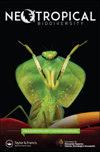Leaf morphoanatomical traits of Jacquinia armillaris Jacq. (Theophrastoideae - Primulaceae) in two xeric shrublands from Venezuela
IF 0.8
Q4 ECOLOGY
引用次数: 1
Abstract
ABSTRACT This study aimed to investigate the leaf anatomy of Jacquinia armillaris plants in two different Venezuelan xeric shrublands to evaluate possible variations caused by the environments, which differ in rainfall and soil salinity. Leaf samples were collected in two sites: La Tortuga Island, a dryer and salty environment than the other collecting site, Turpialito, a coastal location in the mainland. The epidermis and the mesophylls were observed with a light microscope and measured with an ocular micrometer inserted in one of the eyepieces. The results show that J. armillaris has many characteristic anatomical traits of xerophytes, among them: thick cuticles and thick epidermis in both leaf surfaces, stomata only in the abaxial side and epidermal depressions lodging a glandular trichome. Leaves are bifacial and present multistratified palisade parenchyma facing the adaxial epidermis and abaxial spongy parenchyma with abundant intercellular spaces. Furthermore, the hypodermis is composed of one or two cell layers below the upper epidermis. Leaf lamina dimension, petiole, cuticles, epidermis and hypodermis cells, as well as the stomatal occlusive cells and number of trichomes, had differences in size and number when the plants of both sites were compared, being higher in plants from La Tortuga. On the other hand, palisade parenchyma and stomatal density were higher in Turpialito plants. Plants collected in La Tortuga Island showed characteristics that suggest adaptation to the island’s saline and more arid conditions in comparison to plants from Turpialito, which presented more leaf traits related to adaptations to water deficit. These results demonstrate the phenotypic plasticity of J. armillaris plants that grow in two different xeric shrublands.蜜花花叶片形态解剖特征。(报春花科-报春花科)产于委内瑞拉的两个干旱性灌丛
摘要本研究旨在研究委内瑞拉两个不同xeric灌木林中的蜜环菌(Jacquinia armillaris)植物的叶片解剖结构,以评估降雨和土壤盐度不同的环境可能引起的变化。在两个地点采集了叶片样本:La Tortuga岛,这是一个比另一个采集地点Turpialito更干燥、更咸的环境,该地点位于大陆的沿海地区。用光学显微镜观察表皮和叶肉,并用插入其中一个目镜中的目镜进行测量。结果表明,蜜环菌具有许多典型的旱生植物解剖特征,其中:叶片表面角质层厚,表皮厚,气孔仅在背面,表皮凹陷处有腺毛。叶为双面,具有多层栅栏薄壁组织,面向正面表皮和背面海绵状薄壁组织,具有丰富的细胞间隙。此外,皮下组织由上表皮下方的一个或两个细胞层组成。叶片尺寸、叶柄、角质层、表皮和皮下细胞,以及气孔闭塞细胞和毛状体的数量,在比较这两个部位的植物时,在大小和数量上存在差异,在La Tortuga的植物中更高。另一方面,吐鲁番植物栅栏薄壁组织和气孔密度较高。La Tortuga岛上采集的植物表现出的特征表明,与Turpialito岛上的植物相比,它们适应了岛上的盐碱和更干旱的条件,Turpialido岛上的作物表现出更多与适应缺水有关的叶片特征。这些结果证明了生长在两种不同的xeric灌木林中的蜜环菌植物的表型可塑性。
本文章由计算机程序翻译,如有差异,请以英文原文为准。
求助全文
约1分钟内获得全文
求助全文
来源期刊

Neotropical Biodiversity
Environmental Science-Ecology
CiteScore
1.80
自引率
0.00%
发文量
39
审稿时长
24 weeks
 求助内容:
求助内容: 应助结果提醒方式:
应助结果提醒方式:


